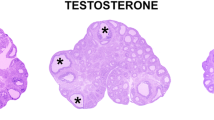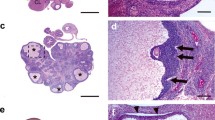Abstract
In the chick, the implantation of a testis graft from a 13-day-old male donor embryo into the extra-embryonic coelom of 3-day-old female embryos induces the total regression of their Müllerian ducts because of the anti-Müllerian hormone (AMH or MIS) secreted by the implant. Pre-treatment of the donors with estradiol (E2), between day 12 and day 13, counteracts in a significant way the Müllero-regressive activity of the implant. Cotreatment of donors at the same stage with both Tamoxifen (TAM) and E2 restores the initially observed activity, thus demonstrating the presence of Tamoxifen-sensitive estrogen receptors at the late stage of treatment in the Sertoli cells responsible for AMH secretion. The treatment of 3-day-old male donor embryos with E2 causes the differentiation of their left gonad into an ovotestis which provides implants totally devoid of Müllero-regressive activity. The additional treatment with TAM of the grafted host embryos, does not modify the results obtained when E2-treated male gonads are grafted to host embryos not treated with TAM. This shows that the lack of Müllero-regressive activity exhibited by the E2treated male gonads does not depend on the estrogens they may secrete during the time of the assay, i.e., it cannot be attributed to a protecting action of estrogens on the MDs of the host. Our results therefore favor the idea that E2 down-regulates AMH. The relevance of such a regulation to the phenomenon of Müllerian duct maintenance, either in the E2-feminized male or in the female chick embryo, is discussed.
Similar content being viewed by others
References
Akram H, Weniger J-P (1969) Sécrétion d'œstrone et d'œstradiol par les gonades embryonnaires d'oiseaux. Gen Comp Endocrinol 112:568–573
Banchard MG, Josso N (1974) Source of the anti-Müllerian hormone synthesised by the fetal testis: Müllerian inhibiting activity of fetal bovine Sertoli cells in tissue culture. Pediatr Res 8:968–971
Coulaud H, Maraud R, Stoll R, Piet M (1969) Nouvelles observations concernant l'activité tératogène de l'œstradiol sur les canaux de Müller de l'embryon d'oiseau femelle. C R Seánces Soc Biol Paris 163:1729–1730
Dantchakoff V (1935) Sur l'inversion sexuelle expérimentale de l'ébauche ovarique chez l'embryon de poulet. C R Seances Soc Biol Paris 120:297–300
Di Clemente N, Ghaffari S, Pepinski RB, Pieau C, Josso N, Gate RL, Vigier B (1992) A quantitative and interspecific test for biological activity of anti-Müllerian hormone: the fetal ovary aromatase assay. Development 114:721–727
Doi O, Hutson JM (1988) Pretreatment of chick embryos with estrogens in ovo, prevents Müllerian duct regression in organ culture. Endocrinology 122:2888–2891
Gasc JM (1991) Distribution and regulation of progesterone receptor in the urogenital tract of the chick embryo. Anat Embryol 183:415–426
Hayashi M, Shima H, Hayashi K, Trelstad RL, Donahoe PK (1984) Immunocytochemical localisation of Müllerian inhibiting substance in the rough endoplasmic reticulum and Golgi apparatus in Sertoli cells of the neonatal calf testis using a monoclonal antibody. J Histochem Cytochem 32:643–654
Hutson J, Ikawa H, Donahoe PK (1981) The ontogeny of Müllerian inhibiting substance in the gonads of the chicken, J Pediatr Surg 16:822–827
Hutson J, Ikawa H, Donahoe PK (1982) Estrogen inhibition of Müllerian inhibiting substance in the chick embryo. J Pediatr Surg 17:953–959
Hutson JM, Donahoe PK, MacLaughlin DT (1985) Steroid modulation of Müllerian duct regression in the chick embryo. Gen Comp Endocrinol 57:88–102
Maraud R, Vergnaud O (1986) Sur la décroissance de la sécrétion de l'hormone anti-müllérienne par le testicule du Poulet au cours du dévelopment. C R Séances Soc Biol Paris 180:521–524
Maraud R, Coulaud H, Stoll R (1969) Influence d l'œstradiol sur la regression des canaux de Müller chez l'embryon de poulet mâle. C R Séances Soc Biol Paris 163:2127–2129
Maraud R, Rashedi M, Stoll R (1982) Influence of a temporary embryonic testis graft on the regression of Müllerian ducts in the female chick embryo. J Embryol Exp Morphol 67:81–87
Münsterberg A, Loveil-Badge R (1991) Expression of the mouse anti-Müllerian hormone gene suggests a role in both male and female sexual differentiation. Development. 113:613–624
Newbold RR, Suzuki Y, MacLachlan JA (1984) Müllerian duct maintenance in heterotypic organ culture after in vitro exposure to diethylstilbestrol. Endocrinology 115:1863–1868
Price JM (1979) The secretion of Müllerian inhibiting substance by cultured isolated Sertoli cells of the neonatal calf. Am J Anat 156:147–157
Salzgeber B, Reyss-Brion M, Baulieu EE (1981) Modifications des gonades femelles de l'embryon de poulet après action du Tamoxifène. C R Acad Sci Paris 293:133–137
Snedecor JG (1949) A study of some effects of sex hormones on the embryonic reproductive system and comb of White Leghorn chick. J Exp Zool 110:205–246
Stoll R, Faucounau N (1987) Sur les déficiences des canaux de Müller induites par la noréthindrone chez l'embryon femelle de Poulet. C R Seances Soc Biol Paris 181:300–306
Stoll R, Rashedi M, Maraud R (1980) Hermaphroditism induced in the female chick by testicular graft. Gen Comp Endocrinol 41:66–75
Stoll R, Rashedi M, Maraud R (1982) Action of estradiol on the hemaphroditism induced by testicular grafts in the female chick embryo. Gen Comp Endocrinol 47:190–199
Stoll R, Faucounau N, Maraud R (1987) Influence of an antiestrogenic drug (Tamoxifen) on Müllerian duct agenesia induced by various steroidal sex hormones in the female chick embryo. Gen Comp Endocrinol 66:218–223
Sutherland R, Foo MS (1980) Synthetic estrogen antagonists in chick oviduct: Antagonism and interaction with estrogen receptors. In: Delrio G (ed) Steroids and their mechanisms of action in non-mammalian vertebrates. Raven Press, New York
Sutherland R, Mester J, Baulieu EE (1977) Tomaxifen is a potent “pure” anti-estrogen in chick oviduct. Nature 267:434–435
Teng CS (1987) Quantification of Müllerian inhibiting substance in developing chick gonads by a competitive enzyme-linked immunosorbent assay. Dev Biol 123:255–263
Tran D, Josso N (1982) Localisation of anti-Müllerian hormone in the rough endoplasmic reticulum of the developing bovine Sertoli cells using immunocytochemistry with a monoclonal antibody. Endocrinology 111:1562–1567
Vigier B, Watrin F, Magre S, Tran D, Josso N (1987) Purified bovine AMH induces a characteristic freemartin effect in fetal rat prospective ovaries exposed to it. Development 100:43–55
Vigier B, Watrin F, Magre S, Tran D, Garrigou O, Josso N (1988) Anti-Müllerian hormone and freemartin: inhibition of germ cell development and induction of seminiferous cord like structures in rat fetal ovaries exposed in vitro to purified AMH. Reprod Nutr Dev 28:1113–1128
Weniger J-P (1965) Régression du canal de Müller d'embryon de poulet mâle de 8 jours cultivé in vitro au contact de gonades femelles du même âge. Z Zellforsch Mikrosk Anat 66:155–160
Weniger J-P, Samsel J, Chouraqui J, Zeis A (1983) Action du Tamoxifène sur la féminisation du testicule embryonnaire de poulet. Ann Endocrinol 44:139–142
Willier BH (1939) The embryonic development of sex. In: Sex and internal secretions, 2nd edn. William & Wilkins, Baltimore, pp 64–144
Willier BH, Gallagher TF, Koch FC (1935) Sex modification in the chick embryo resulting from injection of male and female hormones. Proc Natl Acad Sci USA 21:625–631
Wolff E (1936) L'évolution après l'éclosion des poulets mâles transformés en intersexués par l'hormone femelle injectée aux jeunes embryons. Arch Anat Histol Embryol 23:1–38
Wolff E (1949) L'évolution des canaux de Müller de l'embryon d'oiseau après castration précoce. C R Seances Soc Biol Paris 143:1299
Wolff E (1950) Le rôle des hormones embryonnaires dans la différenciation sexuelle des oiseaux. Arch Anat Microsc Morphol Exp 39:426–450
Wolff E, Ginglinger A (1935) Sur la transformation des poulets mâles en intersexués par l'injection d'hormone femelle (folliculine) aux embryons. Arch Anat Histol Embryol 20:219–278
Woods JE, Erton LH (1978) The synthesis of estrogens in the gonads of the chick embryo. Gen Comp Endocrinol 36:360–370
Author information
Authors and Affiliations
Rights and permissions
About this article
Cite this article
Stoll, R., Ichas, F., Faucounau, N. et al. Action of estradiol and tamoxifen on the Müllero-regressive activity of the chick embryonic testis assayed in vivo by organotypic grafting. Anat Embryol 187, 379–384 (1993). https://doi.org/10.1007/BF00185896
Accepted:
Issue Date:
DOI: https://doi.org/10.1007/BF00185896




